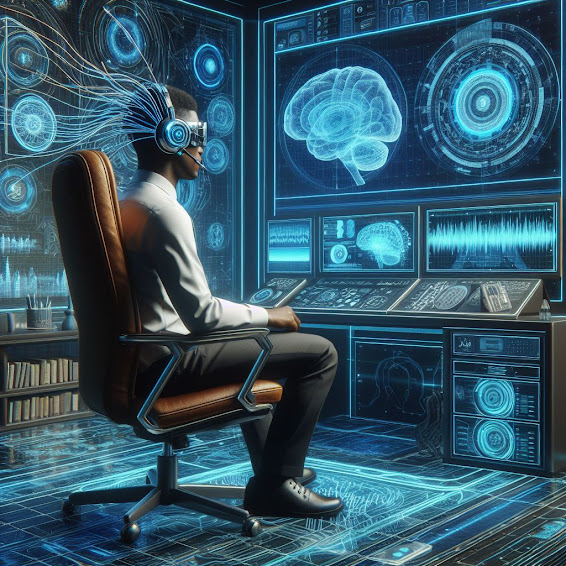Non-Invasive Brain-Computer Interfaces
(BCIs) are systems that facilitate direct communication between the brain and
external devices without the need for surgical procedures. They primarily rely
on techniques that measure brain activity externally, such as
electroencephalography (EEG).
Principles
of Non-Invasive BCIs
1.
Signal Acquisition:
- Non-invasive BCIs capture brain signals using external
sensors placed on the scalp. The most common method employed is:
- Electroencephalography (EEG):
This method detects electrical activity produced by neuronal firing via
electrodes attached to the scalp.
2.
Signal Processing:
- Once the brain signals are acquired, they undergo
signal processing, which includes filtering, amplification, and feature
extraction. The aim is to enhance signal quality and isolate relevant neural
signatures associated with specific thoughts or commands.
3.
Decoding Algorithms:
- Machine learning algorithms are commonly used to decode
the processed signals, translating them into commands for external
devices. These algorithms can be trained to recognize patterns associated
with different mental states or intentions.
Historical
Context
1.
Early Development:
- Research into non-invasive BCIs gained significant
momentum in the 1990s, particularly with the introduction of the concept
by Jonathan Wolpaw . This period marked the transition from
theoretical frameworks to practical applications.
2.
Significant Milestones:
- The emergence of BCI systems for communication and
control marked notable advancements. For instance, systems were developed
that allowed individuals with severe disabilities to control cursors on
screens solely through brain activity.
Mechanisms
of Non-Invasive BCIs
1.
EEG-Based Systems:
- Translating Neural Activity:
Non-invasive systems primarily depend on EEG, where electroencephalographic
signals reflect the overall activity of neuronal populations. These
signals are often classified into different frequency bands, such as
delta, theta, alpha, beta, and gamma, each associated with distinct
cognitive states.
2.
Functional Neuroimaging Techniques
(less common in BCI):
- Other non-invasive methods include:
- Functional Magnetic Resonance Imaging (fMRI):
Measures changes in blood flow related to brain activity but is less
commonly used for real-time applications due to its complexity and cost.
- Functional Near-Infrared Spectroscopy (fNIRS):
Measures brain activity through hemodynamic responses but is limited by
lower temporal resolution compared to EEG.
Applications
of Non-Invasive BCIs
1.
Assistive Technologies:
- Non-invasive BCIs have been successfully implemented to
aid individuals with physical disabilities in operating computers, mobile
devices, and prosthetic limbs. Users can control cursors on screens or
interfaces through mental commands .
2.
Gaming and Entertainment:
- The gaming industry has experience significant interest
in non-invasive BCIs to enhance user experiences. Games that allow players
to control characters or environments using brain activity create a novel
interactive platform.
3.
Rehabilitation:
- Non-invasive BCIs are employed in rehabilitation
settings, especially for stroke patients, where they help in recovery by
facilitating interactions between the user and therapy systems designed to
retrain motor functions.
4.
Research and Neurofeedback:
- Researchers use non-invasive BCIs to study brain
mechanics and neural development. Neurofeedback applications allow
individuals to learn how to self-regulate their brain activity, often
aimed at improving mental health.
Recent
Advancements
1.
Wearable Technology:
- The proliferation of affordable, lightweight EEG
headsets has made non-invasive BCI technology accessible to a broader
audience. Companies such as Emotiv, NeuroSky, and OpenBCI have developed
consumer-friendly devices suitable for various applications .
2.
Improved Signal Processing:
- Advances in algorithms and processing techniques
enhance the accuracy and reliability of signal interpretation, allowing
for smoother interactions and more effective control.
3.
Integration with Augmented Reality (AR):
- There is ongoing research exploring the combination of
non-invasive BCIs with AR systems, which creates immersive environments
where brain activity can control virtual elements within real-world
settings .
Challenges
and Limitations
1.
Signal Quality:
- Non-invasive methods tend to be more susceptible to
noise and interference than invasive techniques, which can affect the
reliability and accuracy of signal interpretation.
2.
Calibration and User Training:
- Many non-invasive BCI systems require initial
calibration and user training for effective operation, which can deter
some users due to the necessary time commitment.
3.
Compatibility Issues:
- The integration of non-invasive BCIs into existing
technologies and everyday environments can face compatibility challenges,
requiring specific adaptations for different applications.
4.
User Acceptance:
- Factors such as ease of use, comfort, and perceived
cognitive load can influence user acceptance of non-invasive BCIs. The
convenience factor is crucial, as long calibration times or the need for
conductive gels can deter users .
Conclusion
Non-Invasive Brain-Computer Interfaces
represent a transformative leap in human-technology interaction, enabling
communication and control entirely through brain activity. Their applications
span assistive technologies, gaming, rehabilitation, and psychological
research. While the technology continues to advance rapidly, addressing
challenges related to signal quality, user experience, and interface
integration is vital for broader acceptance and implementation in daily life.
The ongoing evolution of non-invasive BCIs promises to enhance lives, fostering
new possibilities in various fields as they become more refined and widely
available.


Comments
Post a Comment